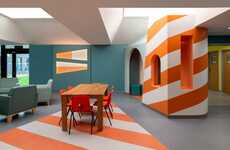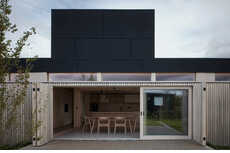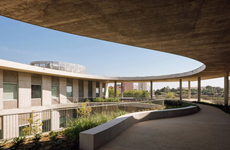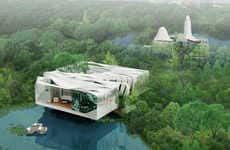
The Livsrum Center Appears as a Cluster of Many Small Houses
Amelia Roblin — January 9, 2014 — Art & Design
The Livsrum Center in Denmark was designed to house cancer counseling services, and this certainly had an influence on the creative architectural approach taken. Patients and their families have a great deal of stress and trauma to deal with and too much time is spent in hospitals. The priority of this project was to make the institution's guests feel more at home.
Because of the diverse range of psychological and social facilities offered by the Næstved center, EFFEKT was required to construct a substantial building. Even though it covers quite a large area, the sections of the structure have been sectioned off to become like irregular row houses with interconnected rooms and lovely shared gardens. The playfully pitched roofs make the Livsrum Center a delightful sight.
Because of the diverse range of psychological and social facilities offered by the Næstved center, EFFEKT was required to construct a substantial building. Even though it covers quite a large area, the sections of the structure have been sectioned off to become like irregular row houses with interconnected rooms and lovely shared gardens. The playfully pitched roofs make the Livsrum Center a delightful sight.
Trend Themes
1. Home-like Institutions - There are opportunities to incorporate residential-like elements into institutional buildings for guests to feel more at home, potentially disrupting traditional institutional designs.
2. Modular Architecture - Modular architectures with interconnected rooms and shared spaces may become more prevalent in future health and social facilities, disrupting traditional institutional design and potentially reducing guests' stress.
3. Multi-functional Centers - There are opportunities to create more integrated centers that house diverse psychological and social facilities in a single location, disrupting traditional institutional designs and making it easier for the guests to access all the necessary services.
Industry Implications
1. Healthcare Facilities - Incorporating residential-like components and modular architecture into healthcare facilities could potentially lead to a more pleasant and comfortable environment for the patients and disrupt the traditional institutionalized healthcare facility design.
2. Architectural Design - A trend towards modular architectures with shared spaces and interconnected rooms in health and social facilities presents opportunities for architectural designers to disrupt traditional institutional design.
3. Social Assistance - The trend towards creating multi-functional centers that house diverse psychological and social facilities in a single location presents possibilities for disrupting traditional institutional designs in the social assistance industry, making it easier for the guests to access all the necessary services.
4.3
Score
Popularity
Activity
Freshness























